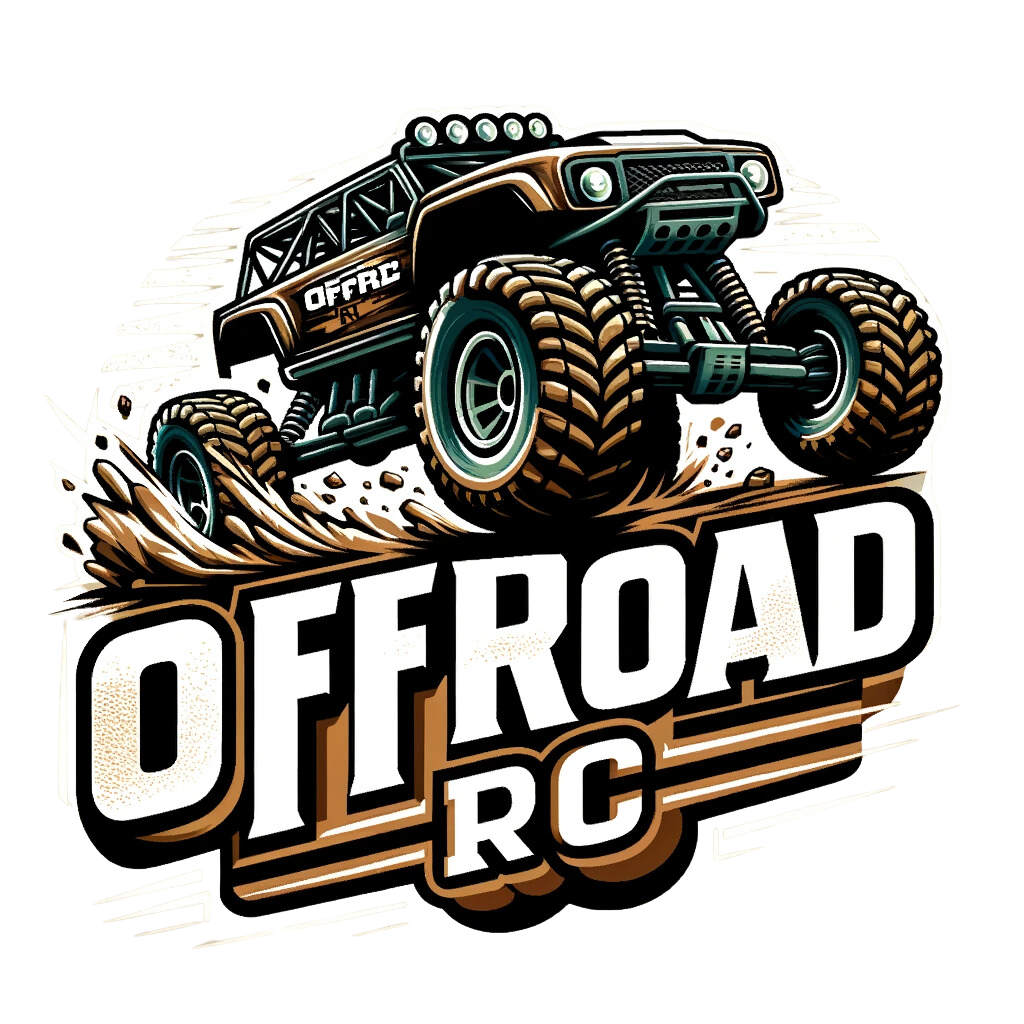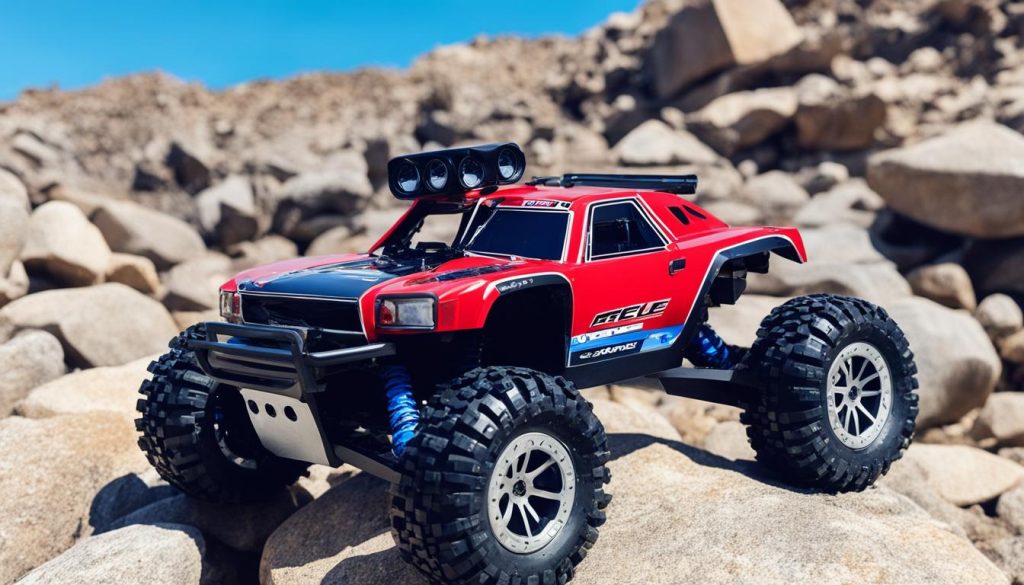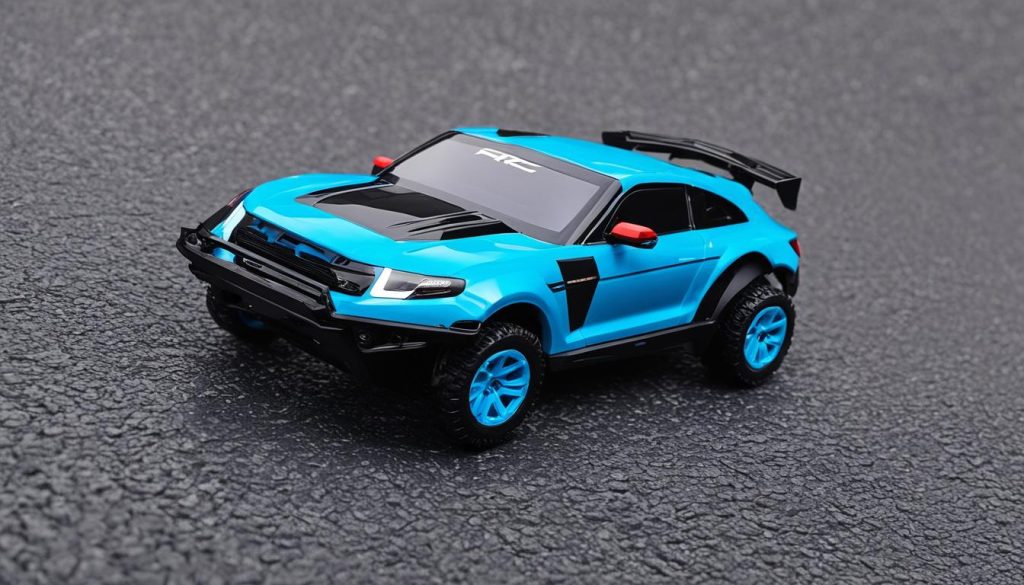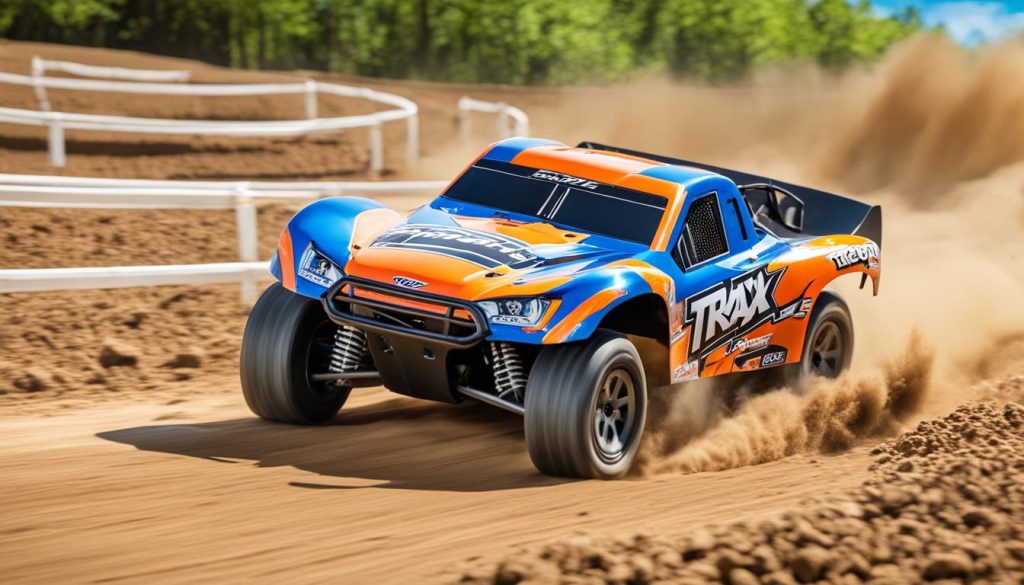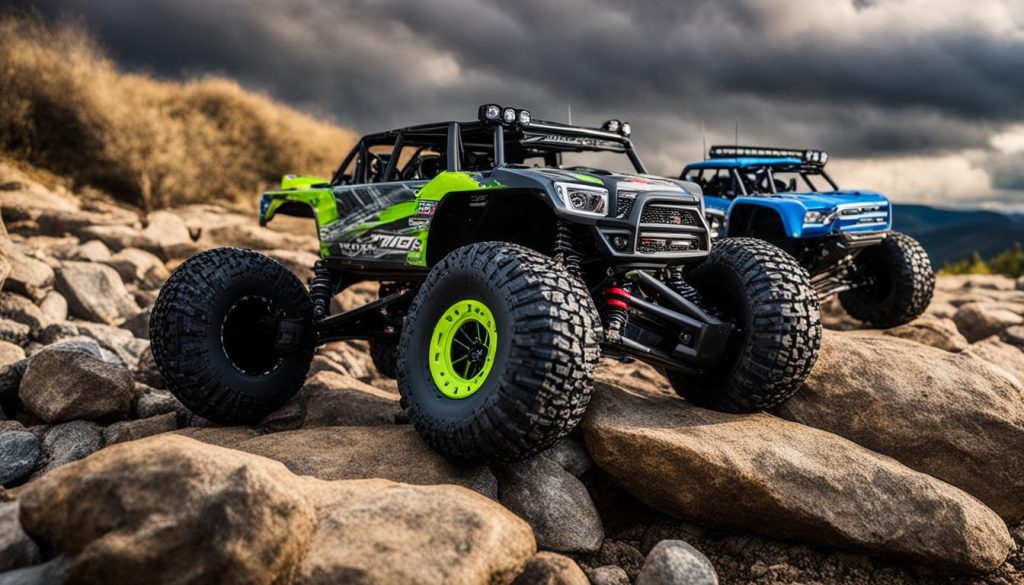Remote control (RC) cars offer endless hours of fun and excitement, but choosing the right scale can be a daunting task. With so many options available, it’s important to consider your needs and preferences before making a decision. In this guide, we will walk you through the different RC car scales and help you determine the best scale RC car for you.
Key Takeaways:
- Understanding the concept of RC car scales is crucial before making a purchase.
- Consider factors such as budget, skill level, intended use, and terrain compatibility.
- The 1:10 scale is a popular choice for beginners, offering a wide range of options.
- Other scales like 1:24, 1:18, and 1:8 cater to different preferences and experiences.
- Carefully consider the pros and cons of each scale before making a final decision.
Understanding RC Car Scales
When it comes to remote control (RC) cars, understanding the different scales is essential for choosing the right model. RC car scales refer to the size of the car model in comparison to a real car. The most common scales in the RC car world are 1:10, 1:8, and 1:5. These numbers represent the ratio of the RC car size to the actual car size.
For instance, a 1:10 scale RC car is 1/10th the size of the real car it is based on. This means that if the real car is 10 feet long, the RC car will be 1 foot long. Similarly, a 1:8 scale RC car is 1/8th the size of the real car, and a 1:5 scale RC car is 1/5th the size.
Understanding these different scales is crucial because it affects various aspects of the RC car, including its performance, handling, and compatibility with different terrains. Depending on your preferences and skill level, you may opt for a smaller or larger scale RC car.
Check out the visual representation below to understand the difference between 1/10 and 1/8 scale RC cars:
| 1/10 Scale RC Car | 1/8 Scale RC Car |
|---|---|
| Smaller in size compared to 1/8 scale | Larger in size compared to 1/10 scale |
| More affordable | Higher cost due to larger size and performance |
| Suitable for beginners and indoor racing | Preferred by experienced hobbyists and outdoor racing |
The table above highlights some of the key differences between 1/10 and 1/8 scale RC cars. Depending on your budget, experience level, and intended usage, you can choose the scale that best suits your needs.
Choosing the Right RC Car Scale
When selecting an RC car scale, consider factors such as:
- Your budget: Larger scales tend to be more expensive.
- Your skill level: Smaller scales may be easier to control for beginners.
- The environment: Smaller scales are suitable for indoor spaces, while larger scales excel in outdoor terrains.
- Intended usage: Different scales offer different capabilities, such as speed, off-road performance, and crawling abilities.
By considering these factors and understanding the differences between RC car scales, you can make an informed decision and choose the perfect RC car for your needs.
Pros and Cons of Different Scales
When it comes to RC car scales, each size has its own set of advantages and disadvantages. Understanding these pros and cons can help you make an informed decision when choosing the right scale for your RC car.
1:10 Scale
The 1:10 scale is one of the most commonly found RC car scales and offers a wide range of models, making it a great choice for beginners. Its versatility allows for both indoor and outdoor racing, providing flexibility in where you can drive. However, one drawback is that it may not be the fastest option available.
1:8 Scale
The 1:8 scale is highly popular among experienced hobbyists due to its high-speed performance and thrilling off-road experience. It offers a more powerful and aggressive driving experience, making it ideal for those seeking adrenaline-fueled adventures. However, it may not be as readily available as the 1:10 scale, and the prices of 1:8 scale models can be higher.
Here’s a visual comparison of the pros and cons of the two scales:
| RC Car Scale | Advantages | Disadvantages |
|---|---|---|
| 1:10 |
|
|
| 1:8 |
|
|
Exploring 1/10 Scale RC Cars
The 1/10 scale RC cars are highly recommended for beginners due to their widespread availability and diverse range of models. Whether you’re interested in crawling or on-road racing, these RC cars offer a perfect balance between performance and versatility.
Although they might not be the fastest option available, their reliability and ease of use make them ideal for those new to the hobby. The 1/10 scale RC cars are also compatible with various terrains, making them suitable for both indoor and outdoor environments.
One of the best 1/10 scale RC cars for beginners is the Xray XB4D 2023 Dirt Edition 1/10 4WD Electric Buggy Kit. It features a durable build and a 4-wheel drive system, providing excellent traction and handling on different types of surfaces. With its advanced suspension system and adjustable settings, this RC car offers a smooth and customizable driving experience for beginners.
Rodrigo Gomez, an experienced RC car enthusiast, enthuses about the Xray XB4D 2023 Dirt Edition:
“The Xray XB4D 2023 Dirt Edition is a fantastic 1/10 scale RC car for beginners. Its electric powertrain delivers consistent performance, while the 4-wheel drive system ensures excellent control and stability. This RC car is easy to assemble and tune, making it perfect for those who are just starting out in the hobby.”
Key Features of 1/10 Scale RC Cars:
| Feature | Description |
|---|---|
| 1. Versatility | 1/10 scale RC cars are suitable for both crawling and on-road racing, offering a wide range of options for beginners. |
| 2. Availability | These RC cars are widely available, ensuring easy access to replacement parts and upgrades. |
| 3. Compatibility | 1/10 scale RC cars can navigate various terrains, providing an enjoyable driving experience both indoors and outdoors. |
| 4. Customizability | Many 1/10 scale RC cars offer customizable features and adjustable settings, allowing beginners to fine-tune their vehicle’s performance. |
| 5. Durability | These RC cars are built to withstand rough conditions, making them perfect for beginners who are still refining their driving skills. |
Exploring Other RC Car Scales
In addition to the 1:10 scale, there are other RC car scales available that cater to different preferences and needs. Let’s take a closer look at three popular scales: 1/24, 1/18, and 1/8.
1/24 Scale RC Car
The 1/24 scale is significantly smaller compared to the 1/10 scale, making it the perfect choice for those who prefer compact-sized RC cars. These miniature vehicles are suitable for crawling and can easily navigate tight spaces. Although they may lack the speed and power of larger scales, their smaller size allows for intricate indoor track setups. Notable features of 1/24 scale RC cars include:
- Miniature size for easy maneuverability
- Perfect for indoor tracks and setups
- Ideal for crawling and precision driving
- Requires less space for storage and transportation
1/18 Scale RC Car
The 1/18 scale falls between the smaller 1/24 scale and the larger 1/10 scale. It offers a medium-sized option that suits those who want a balance between size and performance. 1/18 scale RC cars are popular among enthusiasts who enjoy rock crawling and off-road adventures. Key features of 1/18 scale RC cars include:
- Medium-sized for a good balance of performance and maneuverability
- Great for outdoor off-road driving
- Provides a thrilling experience on various terrains
- Mini rock crawlers available for those who prefer smaller scales
1/8 Scale RC Car
The 1/8 scale RC cars are larger and offer a more exhilarating experience. They are favored by experienced hobbyists who are looking for high-speed performance and versatility. Whether you prefer on-road or off-road activities, the 1/8 scale RC cars can handle both terrains with ease. Notable features of 1/8 scale RC cars are:
- Larger size for impressive speed and power
- Great for both on-road and off-road adventures
- Provides a thrilling experience for experienced hobbyists
| Scale | Description |
|---|---|
| 1/24 | Miniature size for crawling and compact size |
| 1/18 | Medium-sized option for rock crawling and off-road driving |
| 1/8 | Larger scale for high-speed performance and thrilling adventures |
Factors to Consider When Choosing an RC Car Size
Before making a final purchase, there are several factors to consider when choosing the right size RC car. These factors will ensure that you choose a car that meets your needs and provides an enjoyable experience.
Budget
Your budget is an important consideration when selecting an RC car size. Larger models tend to be more expensive due to their increased complexity and features. If you’re a beginner or have a limited budget, starting with a smaller size may be a more cost-effective option.
Environment
The environment in which you plan to use your RC car is another crucial factor to consider. Larger models may not be suitable for indoor use or narrow outdoor spaces. If you have limited space or plan to primarily drive your car indoors, opting for a smaller size is recommended. On the other hand, if you have ample outdoor space, a larger size may provide more versatility and enjoyment.
Skill Level
Consider your skill level when choosing an RC car size. Smaller models can be more challenging to control, especially for beginners. If you’re new to RC cars, starting with a larger size can offer a more forgiving and stable driving experience. As you gain experience and confidence, you can gradually transition to smaller sizes or more advanced models.
By taking these factors into account, you can make an informed decision and choose the right size RC car that suits your budget, environment, and skill level.
Tips for Getting the Most Out of Your RC Car
To maximize your enjoyment with your RC car, it’s important to follow maintenance and care tips. Regularly tightening screws, checking for damaged parts, and cleaning driveshafts are some essential maintenance tasks. When driving, take your time to get used to the controls and avoid driving in unsuitable areas. Understanding the power source of your RC car, such as electric, gas, or nitro, is also crucial in determining its speed and performance.
Here are some key tips to help you get the most out of your RC car:
- Regular Maintenance: Regularly tighten screws using a screwdriver to prevent loose parts and ensure smooth operation. Check for damaged components such as tires, suspension, and body parts and replace them when necessary. Clean and lubricate the driveshafts to maintain optimal performance.
- Start Slowly: If you’re new to RC cars, take your time to learn the controls and gradually increase your speed and agility. Practice in open areas away from obstacles and traffic to avoid accidents and damage to your RC car.
- Choose Suitable Terrain: Make sure to choose the right type of terrain for your RC car. Some models are designed for off-road driving, while others are better suited for smooth surfaces. Driving the wrong type of RC car on unsuitable terrain can lead to poor performance and damage.
- Power Source Considerations: Different RC cars use different power sources, such as electric, gas, or nitro. Electric RC cars are typically easier to maintain and operate, while gas and nitro options offer greater speed and power. Consider your preferences and skill level when choosing the power source.
Remember, taking care of your RC car and understanding its power source are essential for optimal performance and longevity. By following these tips, you’ll be able to enjoy countless hours of driving fun with your RC car.
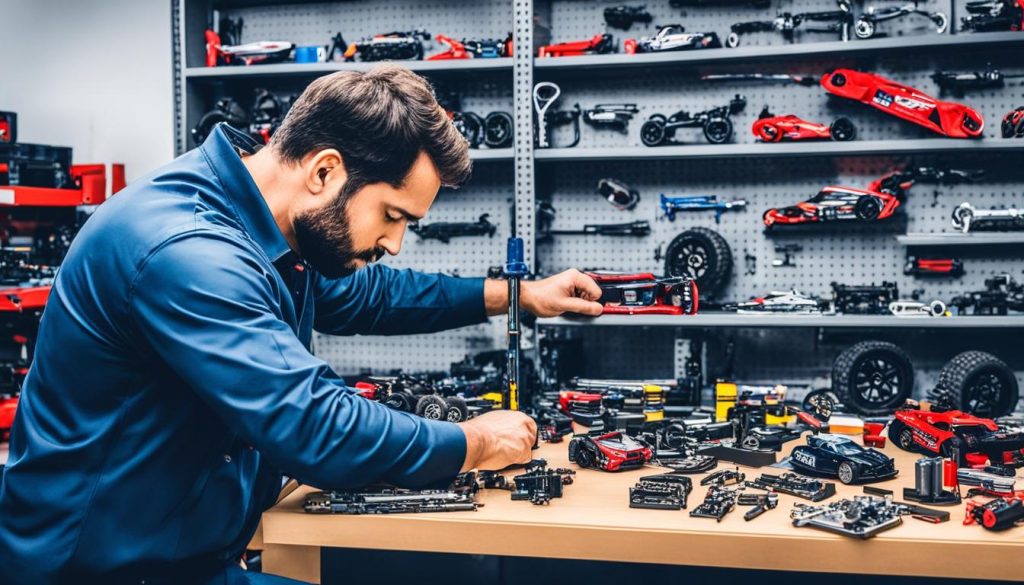
Customizing and Upgrading Your RC Car
Customizing and upgrading your RC car can greatly enhance its performance and create a personalized experience that matches your preferences. Whether you’re a beginner or an experienced enthusiast, there are various popular modifications and upgrades you can consider to take your RC car to the next level.
1. Upgrading Shock Caps
By upgrading the shock caps on your RC car, you can improve its shock absorption capabilities and overall stability. High-quality shock caps provide better control and enhance your car’s performance, especially when driving on rough terrains.
2. Replacing Control Arms
Upgrading the control arms of your RC car can offer increased durability and better suspension geometry. This modification enhances handling and allows for smoother cornering, giving you better control over your vehicle.
3. Trying Out New Tires
Experimenting with different types of tires is a popular customization option for maximizing performance on various terrains. Depending on your driving style and the surface you’re racing on, you can choose tires with different tread patterns, compounds, and firmness levels.
4. Upgrading Battery Power
Increasing the battery power of your RC car can result in faster acceleration and higher top speeds. Upgrading to a higher voltage or capacity battery pack can provide more power to the motor, allowing for increased performance and longer run times.
5. Replacing the Transmitter
The transmitter is the device you use to control your RC car. Upgrading to a higher-quality transmitter can offer improved signal strength, better range, and more precise control. This upgrade can significantly enhance your driving experience and responsiveness.
Customizing and upgrading your RC car not only enhances its functionality but also allows you to express your personal style and preferences. These modifications can improve the durability, speed, and handling of your RC car, ensuring a more enjoyable and customized racing experience.
Choosing the Right RC Car for Your Terrain
When it comes to choosing the right RC car, considering the terrain you plan to drive on is crucial. Different terrains require different types of vehicles to ensure optimal performance and enjoyment. Let’s take a closer look at the terrain compatibility of various RC cars to help you make an informed decision.
Grass and Dirt
If you plan to tackle grassy fields or dirt tracks, short course trucks and monster trucks are excellent options. These RC cars are designed with rugged suspensions, large tires, and powerful motors to handle rough terrains. They offer excellent traction and stability, allowing you to navigate through grass and dirt with ease.
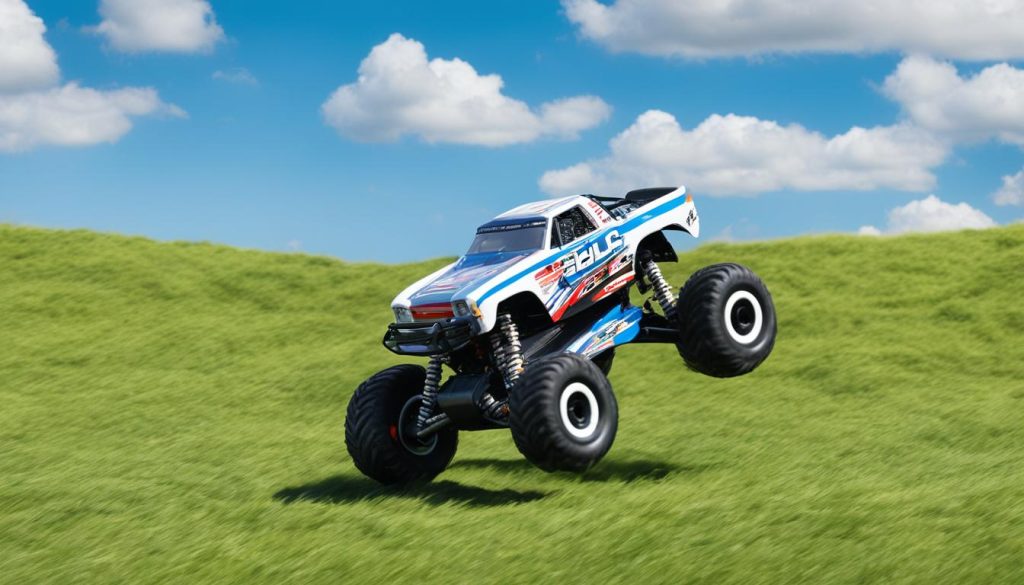
Rocky Terrains
For rocky terrains, rock crawlers are the perfect choice. These specialized RC cars are equipped with extreme grip tires, high ground clearance, and advanced suspension systems. They are designed to overcome obstacles such as rocks, boulders, and uneven surfaces. With their precise control and slow-speed capabilities, rock crawlers provide an exciting off-road experience.
Pavement and Concrete
If you prefer racing on smoother surfaces like pavement or concrete, on-road RC cars are the way to go. These cars are built for speed, featuring aerodynamic bodies, low-profile tires, and powerful motors. On-road RC cars excel in straight lines and sharp turns, delivering thrilling high-speed performance on smooth surfaces.
Other Terrains
Other terrains, such as gravel paths or sand dunes, may require specific RC cars that suit the unique challenges they present. It’s essential to research and choose RC cars specifically designed for those terrains to ensure optimal performance and durability.
Below is a table summarizing the terrain compatibility of different RC cars:
| Terrain | Recommended RC Car |
|---|---|
| Grass and Dirt | Short Course Trucks and Monster Trucks |
| Rocky Terrains | Rock Crawlers |
| Pavement and Concrete | On-Road RC Cars |
| Other Terrains | Specifically Designed RC Cars |
By considering the compatibility of different RC cars with various terrains, you can ensure that you choose the right vehicle for your intended driving environment. This will allow you to have the best possible RC car experience, whether you’re conquering rocky trails or racing on smooth surfaces.
Bashing vs. Racing RC Cars
When it comes to RC cars, there are two main categories: bashing and racing. Each type offers a unique experience and caters to different preferences. Whether you’re looking for an adrenaline-fueled competition or a casual off-road adventure, understanding the differences between bashing and racing RC cars will help you make the right choice.
Bashing RC Cars
If you’re all about having fun and pushing the limits of your RC car, bashing is the way to go. Bashing refers to casual driving and off-road adventures where you can unleash the full potential of your vehicle. These RC cars are built for durability and can handle rough terrain and jumps with ease.
Basher vehicles are designed to withstand the toughest conditions and offer fantastic stability and control. They generally feature robust suspension systems, strong chassis, and large, grippy tires that can conquer any surface. Bashing RC cars prioritize durability and fun, making them a great choice for beginners and enthusiasts who want to enjoy the thrill of off-road driving.
Racing RC Cars
If you’re more interested in competitive racing and pushing your skills to the limit, racing RC cars are the way to go. Racing involves organized and thrilling competitions on tracks where speed and performance are paramount. These RC cars are designed to deliver exceptional acceleration, handling, and top speeds.
Racing vehicles are engineered for optimum performance, featuring lightweight designs, streamlined bodies, and powerful motors. These RC cars excel in precision driving and can take sharp turns at high speeds. Racing RC cars often come with advanced features like adjustable suspension and aerodynamic enhancements to maximize speed and cornering capabilities.
Choosing the Right RC Car for You
When choosing between bashing and racing RC cars, consider your intended use and preferences. If you prioritize durability, off-road capabilities, and casual driving fun, a bashing RC car is the way to go. On the other hand, if you crave high-speed thrills, intense competition, and precision driving, a racing RC car will provide the excitement you’re looking for.
Ultimately, the choice between bashing and racing RC cars comes down to your personal preferences and the type of experience you want to have. No matter which category you choose, RC car enthusiasts of all levels can enjoy the excitement and joy of remote control car driving.
| Bashing RC Cars | Racing RC Cars | |
|---|---|---|
| Durability | High | Medium |
| Speed | Medium | High |
| Off-Road Capabilities | Excellent | Poor |
| Precision Driving | Poor | Excellent |
| Competition | Casual | Organized |
Brushed vs. Brushless Motors for RC Cars
When it comes to RC cars, the type of motor you choose can greatly impact its performance and durability. Two common options you’ll come across are brushed and brushless motors. Let’s dive into the differences between these two types and help you make an informed decision for your RC car.
Brushed Motors for RC Cars
Brushed motors are the more affordable and commonly found option in RC cars. They use brushes to transfer electricity to the motor’s rotor, creating rotational motion. While they may not offer the same power and efficiency as brushless motors, they do have their advantages.
Quote: “Brushed motors are a great choice for beginners and hobbyists on a budget. They provide reliable performance and are easy to maintain.”
Some key characteristics of brushed motors for RC cars include:
- Lower cost
- Simple design
- Easy maintenance
- Availability of replacement parts
Brushless Motors for RC Cars
Brushless motors, on the other hand, offer higher performance and efficiency compared to brushed motors. They eliminate the need for brushes by using electronic commutation. This results in smoother and more precise control, increased power output, and longer lifespan.
Quote: “Brushless motors are the go-to choice for experienced hobbyists and those looking for top-notch performance. They deliver exceptional speed, acceleration, and durability.”
Here are some notable features of brushless motors for RC cars:
- Higher cost
- Advanced technology and design
- Improved power-to-weight ratio
- Longer lifespan
Choosing between brushed and brushless motors depends on the desired speed, power, and budget for your RC car. If you’re a beginner or on a limited budget, a brushed motor may be a suitable starting point. However, if you’re seeking top-level performance and are willing to invest more, a brushless motor is the way to go.
| Brushed Motors | Brushless Motors |
|---|---|
| Lower cost | Higher cost |
| Simple design | Advanced technology and design |
| Easy maintenance | Longer lifespan |
| Availability of replacement parts | Improved power-to-weight ratio |
Conclusion
Choosing the right scale RC car is essential for a thrilling and satisfying RC car experience. When selecting the size of your RC car, take into consideration factors such as your budget, the environment you’ll be driving in, your skill level, and your intended use. By following maintenance tips, personalizing and upgrading your car, and selecting a vehicle that suits your preferred terrain, you can optimize your enjoyment and performance.
For beginners, the 1:10 scale RC cars are a fantastic choice due to their wide availability and variety of models. They are versatile, suitable for both crawling and on-road racing. However, keep in mind that they may not be ideal for indoor spaces and are not the fastest option available. Alternatively, experienced hobbyists often prefer the 1:8 scale RC cars, which provide high-speed performance and an exhilarating off-road experience.
Regardless of whether you’re new to RC cars or an experienced enthusiast, finding the right RC car scale will enhance your driving skills and provide endless hours of fun. So, consider your preferences and requirements, choose the perfect scale RC car, and get ready to unleash your inner racer!
FAQ
What scale RC car should I get?
The scale of the RC car you should get depends on your preferences and needs. Factors to consider include your budget, skill level, intended use, and the environment in which you will drive the RC car. Different scales have their own advantages and disadvantages, so it’s important to choose the one that suits you best.
What are the best scale RC cars?
The best scale RC cars can vary depending on personal preferences and specific needs. However, the 1:10 scale is commonly recommended for beginners due to its availability and variety of models. It offers a good balance between performance, versatility, and affordability.
Can you explain the different RC car scales?
RC car scales refer to the size of the remote control car model compared to the real car it is based on. The most common scales are 1:10, 1:8, and 1:5. These numbers represent the ratio of the RC car size to the real car size. For example, a 1:10 scale RC car is 1/10th the size of the actual car.
What are the pros and cons of different RC car scales?
Each RC car scale has its own advantages and disadvantages. The 1:10 scale is versatile, suitable for both indoor and outdoor racing, and offers a wide range of models for beginners. However, it may not be the fastest option available. The 1:8 scale is popular among experienced hobbyists, providing high-speed performance and a thrilling off-road experience.
What are the features of 1:10 scale RC cars?
1:10 scale RC cars are a popular choice for beginners. They are versatile and suitable for both crawling and on-road racing. However, they may not be ideal for indoor spaces and are not the fastest option available. A popular example of a 1:10 scale RC car for beginners is the Xray XB4D 2023 Dirt Edition 1/10 4WD Electric Buggy Kit.
What are the features of other RC car scales?
There are other RC car scales available, such as 1:24, 1:18, and 1:8. The 1:24 scale is much smaller and suitable for crawling and compact size. The 1:18 scale is medium-sized and offers mini rock crawlers for those not interested in smaller scales. The 1:8 scale is popular for both on-road and off-road activities, providing a thrilling experience for experienced hobbyists.
What factors should I consider when choosing an RC car size?
When choosing an RC car size, consider factors such as your budget, the environment in which you will use the RC car, your skill level, and your intended use. Larger models tend to be more expensive and may not be suitable for indoor or narrow outdoor spaces. Smaller models may be more challenging to control for beginners.
What are some tips for getting the most out of my RC car?
To get the most out of your RC car, regularly tighten screws, check for damaged parts, and clean driveshafts. Take your time to get used to the controls and avoid driving in unsuitable areas. Understand the power source of your RC car, such as electric, gas, or nitro, as it will determine its speed and performance.
How can I customize and upgrade my RC car?
You can customize and upgrade your RC car to enhance its performance and personalize your experience. Popular customization options include upgrading shock caps, replacing control arms, trying out new tires for different terrains, upgrading battery power, and replacing the transmitter. These modifications can improve the durability, speed, and handling of your RC car.
How do I choose the right RC car for different terrains?
The terrain you plan to drive your RC car on impacts the type of vehicle you should choose. Grass, pavement, dirt, gravel, and sand dunes each have their own considerations. Different RC car models, such as short course trucks, monster trucks, and rock crawlers, are designed for specific terrains. Understanding the terrain compatibility of different RC cars will help you make an informed decision.
What’s the difference between bashing and racing RC cars?
Bashing refers to casual driving and off-road adventures with RC cars, while racing involves organized competitions on tracks. Basher vehicles prioritize durability and fun, while racing vehicles focus on performance and speed. Choose between a bashing or racing RC car based on your intended use and preferences.
What’s the difference between brushed and brushless motors for RC cars?
RC cars can be equipped with either brushed or brushless motors. Brushed motors are cheaper and more commonly found, while brushless motors offer higher performance and efficiency. Brushed motors are more susceptible to wear and tear, while brushless motors are more durable. Consider your desired speed and power when choosing between brushed and brushless motors for your RC car.
